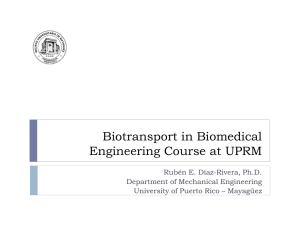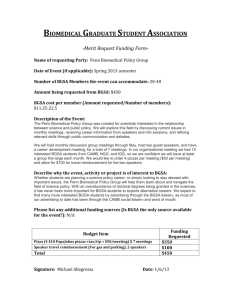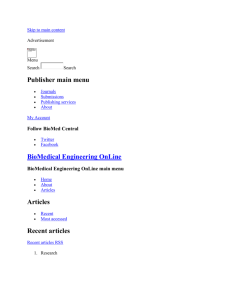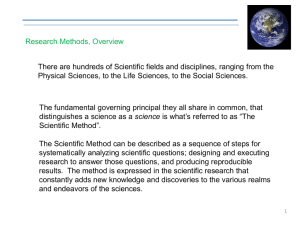Biomedical Waste Management Policy & Procedure
advertisement
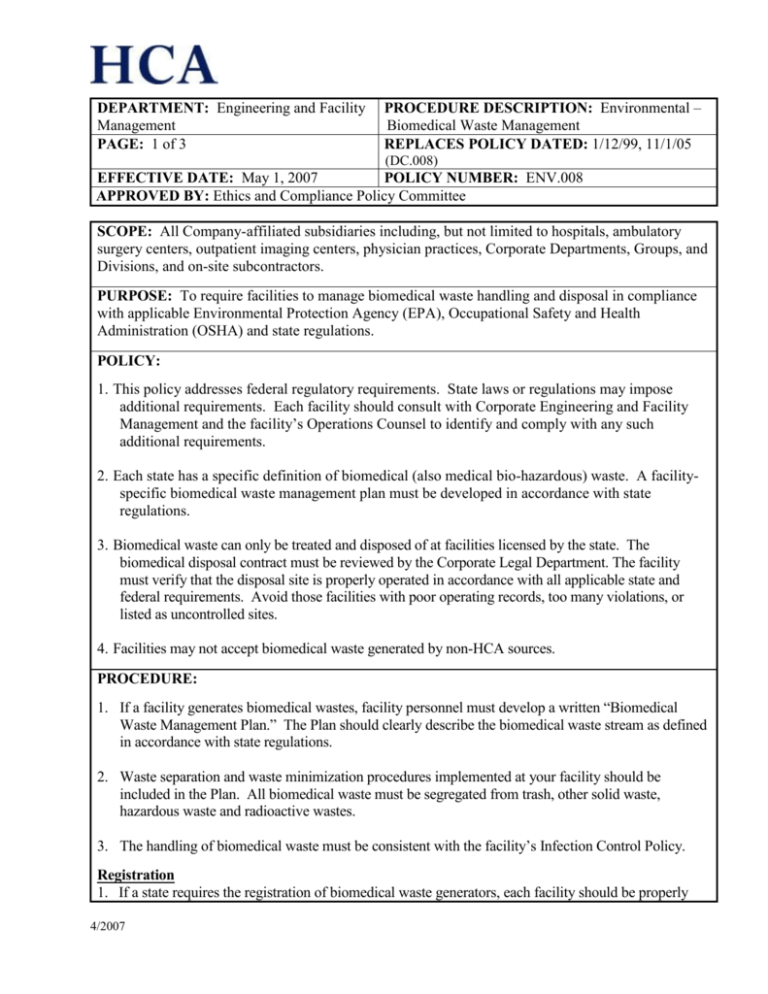
DEPARTMENT: Engineering and Facility Management PAGE: 1 of 3 PROCEDURE DESCRIPTION: Environmental – Biomedical Waste Management REPLACES POLICY DATED: 1/12/99, 11/1/05 (DC.008) EFFECTIVE DATE: May 1, 2007 POLICY NUMBER: ENV.008 APPROVED BY: Ethics and Compliance Policy Committee SCOPE: All Company-affiliated subsidiaries including, but not limited to hospitals, ambulatory surgery centers, outpatient imaging centers, physician practices, Corporate Departments, Groups, and Divisions, and on-site subcontractors. PURPOSE: To require facilities to manage biomedical waste handling and disposal in compliance with applicable Environmental Protection Agency (EPA), Occupational Safety and Health Administration (OSHA) and state regulations. POLICY: 1. This policy addresses federal regulatory requirements. State laws or regulations may impose additional requirements. Each facility should consult with Corporate Engineering and Facility Management and the facility’s Operations Counsel to identify and comply with any such additional requirements. 2. Each state has a specific definition of biomedical (also medical bio-hazardous) waste. A facilityspecific biomedical waste management plan must be developed in accordance with state regulations. 3. Biomedical waste can only be treated and disposed of at facilities licensed by the state. The biomedical disposal contract must be reviewed by the Corporate Legal Department. The facility must verify that the disposal site is properly operated in accordance with all applicable state and federal requirements. Avoid those facilities with poor operating records, too many violations, or listed as uncontrolled sites. 4. Facilities may not accept biomedical waste generated by non-HCA sources. PROCEDURE: 1. If a facility generates biomedical wastes, facility personnel must develop a written “Biomedical Waste Management Plan.” The Plan should clearly describe the biomedical waste stream as defined in accordance with state regulations. 2. Waste separation and waste minimization procedures implemented at your facility should be included in the Plan. All biomedical waste must be segregated from trash, other solid waste, hazardous waste and radioactive wastes. 3. The handling of biomedical waste must be consistent with the facility’s Infection Control Policy. Registration 1. If a state requires the registration of biomedical waste generators, each facility should be properly 4/2007 DEPARTMENT: Engineering and Facility Management PAGE: 2 of 3 PROCEDURE DESCRIPTION: Environmental – Biomedical Waste Management REPLACES POLICY DATED: 1/12/99, 11/1/05 (DC.008) EFFECTIVE DATE: May 1, 2007 POLICY NUMBER: ENV.008 APPROVED BY: Ethics and Compliance Policy Committee registered with the agency as a bio-medical waste generator. A copy of the registration and agency inspection records must be kept at the facility. 2. On-site incineration of biomedical waste, if any, must be done in accordance with federal and/or state air pollution control regulations. Each facility with an operational incinerator must keep a medical waste incinerator permit, a permit exemption, or proof of permit-by-rule. Facilities may not deposit waste materials other than biomedical wastes in the medical waste incinerator. A one-time analytical test (TCLP-metals) must be performed for the incinerator ash. The facility must ask for a copy of the analytical test results and keep it on file. Handling 1. Never mix biomedical waste with other types of waste materials (such as regular trash or hazardous waste). 2. Wastes must be properly labeled and tagged with appropriate bio-hazard warnings. 3. Biomedical waste collected for on-site incineration or off-site disposal should be stored in a secure manner and in a location where the waste is protected from theft, vandalism, inadvertent human or animal exposure, rain, water, and wind. The waste storage time should be less than 7 days or the retention time limited by the state regulations. 4. Weekly visual inspection of medical waste storage is required. 5. If the facility incinerates biomedical waste on-site, the operating records should include a. Date of incineration; b. Amount and type of bio-medical waste incinerated; c. Name and initials of person(s) performing incineration; and d. Special equipment conditions and incineration temperature chart. Transportation 1. Each shipment of biomedical waste must be accompanied by a properly executed EPA nonhazardous waste manifest. A facility must keep the original copy of the manifest. Biomedical waste must be packaged in a DOT approved containers with proper label and warning. 2. Some states have special disposal requirements for sharp wastes, pathology wastes, and chemotherapy waste. Facility personnel must review state requirements thoroughly to achieve full compliance. 4/2007 DEPARTMENT: Engineering and Facility Management PAGE: 3 of 3 PROCEDURE DESCRIPTION: Environmental – Biomedical Waste Management REPLACES POLICY DATED: 1/12/99, 11/1/05 (DC.008) EFFECTIVE DATE: May 1, 2007 POLICY NUMBER: ENV.008 APPROVED BY: Ethics and Compliance Policy Committee 3. Untreated biomedical wastes are to be released to a biomedical waste transporter licensed by the Department of Transportation (DOT) and the relevant state agency. It is not acceptable for facility personnel to transport bio-medical wastes. 4. The facility must verify the registration (with DOT and State Environmental Agency) of the biomedical waste transporter and have the transporter sign the manifest for each removal. Disposal 1. The facility must have biomedical waste disposed of at an EPA and state registered treatment or disposal site. 2. After a shipment of biomedical waste is removed, the manifest must be signed by the transporter and the ultimate disposal facility and returned to the facility. The facility should receive an executed manifest signed and returned by the treatment/disposal facility within 30 days after the removal from the facility. If this manifest is not received, the facility must call the disposal facility and request the executed manifest. RECORDKEEPING: Depending on the method of biomedical waste disposal, the records file should include at least: Original state registration notification form for medical waste generators; Certification from red bag and sharp container vendors indicating material properties and testing data; A copy of off-site hauling contracts; A copy of the Resource Conservation and Recovery Act (RCRA) permit from each medical waste transporter and disposal facility used; Waste pickup logs All manifests, receipts, certificates of destruction/disposal, or equivalent documents; Analytical results of incinerator ashes; Monthly inspection (by facility personnel) logs; Personnel training records; and Agency visit/inspection records. REFERENCES: Facility Infection Control Policy OSHA 29 CFR 1910.1030 Federal Regulations 40 CFR 266 4/2007


